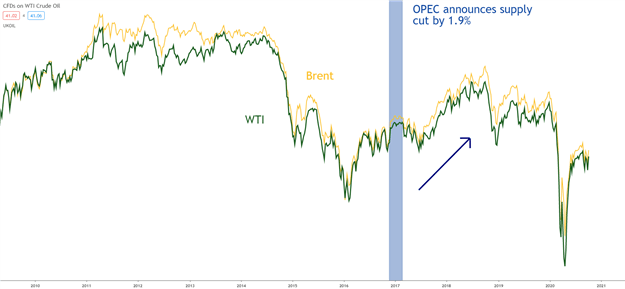Crude Oil Trading Strategies and Tips (Part 1)
Crude Oil Trading Strategies and Tips
- Crude oil is ranked among the most liquid commodities in the world, meaning high volumes and clear charts for oil trading.
- Oil traders should understand how supply and demand affects the price of oil.
- Both fundamental and technical analysis is useful for oil trading and allows traders to gain an edge over the market.
- Traders should follow a risk conscious crude oil trading strategy for greater consistency and efficiency.
WHY TRADE CRUDE OIL AND HOW DOES CRUDE OIL TRADING WORK?
Pipscollector.com - Crude oil is the world economy’s primary energy source, making it a very popular commodity to trade. A naturally occurring fossil fuel, it can be refined into various products like gasoline (petrol), diesel, lubricants, wax and other petrochemicals. It is highly demanded, traded in volume, and extremely liquid. Oil trading therefore involves tight spreads, frequent chart patterns, and high volatility.
Brent crude is the world’s benchmark for oil with almost two thirds of oil contracts traded being Brent oil. WTI is America’s benchmark oil, it is a slightly sweeter and lighter oil compared to Brent.
CRUDE OIL TRADING HOURS
WTI trades on CME Globex:
Sunday - Friday, 6:00 p.m. - 5:00 p.m. (with an hour break from 5:00 p.m. to 6:00 p.m. each day)
Brent trades on ICE:
Sunday - Friday - 7:00 p.m. - 5:00 p.m.
CRUDE OIL TRADING BASICS: UNDERSTANDING WHAT AFFECTS PRICE MOVEMENTS
When trading oil, the two major focal points are, as with many commodities, supply and demand. Whether there was an economic report like a news event or press release or tensions in the Middle East, the two factors that will be taken into consideration is how supply and demand is affected, because this will affect the price.
Supply Factors
- Outages or maintenance in key refineries around the globe, whether it’s the Forties pipeline in the North Sea or the Port Arthur refinery in Texas, must be monitored because of the effect it can have on the supply of oil. War in the Middle East leads to concerns about supply. For example, when the Libyan Civil war began in 2011, prices had seen a 25% rise from in the space of a couple of months.
- OPEC (Organization of the Petroleum Exporting Countries) production cuts or extensions lead to changes in the price of oil. For example, back in 2016 when the cartel had announced their decision to curb global supply by 1.9% (see chart below), the price of oil has risen from $44/bbl to as much as $80/bbl.
WTI and Brent Crude price reaction to OPEC supply cut:

Chart prepared by Warren Venketas, TradingView
- Oil Suppliers: Similarly, with understanding the importance of OPEC, it is also worth knowing who the top global oil suppliers are, and this information can be fond from the EIA website.
Demand Factors
- Seasonality: Hot summers can lead to increased activity and higher oil consumption. Cold winters cause people to consume more oil products to heat their houses.
- Oil Consumers: The largest consumers of oil have typically been developed nations such as the U.S. and European countries. However, in recent times there has been a surge in oil consumption in Asian countries, namely China and Japan. As such, it is important for traders to pay attention to the level of demand from these nations, alongside their economic performance. Any slowdown could affect oil prices and demand may fall.
- Correlation to Global Growth: The chart below shows the largely positive correlation between the price of crude oil and global growth. The Chinese and US economies being the two largest in the world are a great barometer for global growth. The chart includes their respective major stock indices which move in line with crude oil prices – when the equity indices fall, the price of crude oil tends to fall and vice versa.
WTI and Brent Crude positive correlation with FTSE China A50 and S&P 500 chart representation:

- Alternative Energy: While fossil fuels such as oil and gas continue to dominate cleaner energy sources, there is an incessant push towards sustainability on a global scale. This will definitely impact crude oil prices going forward which makes this a key factor to monitor in a crude oil trading strategy.
The impact of derivatives on the traditional valuations of crude oil have been thought by many to have destabilized the asset class. Simply put, the oil futures are thought to have reflected higher proportions of noise which do not reflect the fundamental data at the time. This is contentious within the investing community with some in disagreement with the above rationale, but it cannot be ignored that large speculative traders are becoming more influential with the flourishing derivative market.
Read more articles in the Educational Content category to update the latest forex knowledge from Pipscollector.
- Pipscollector -
